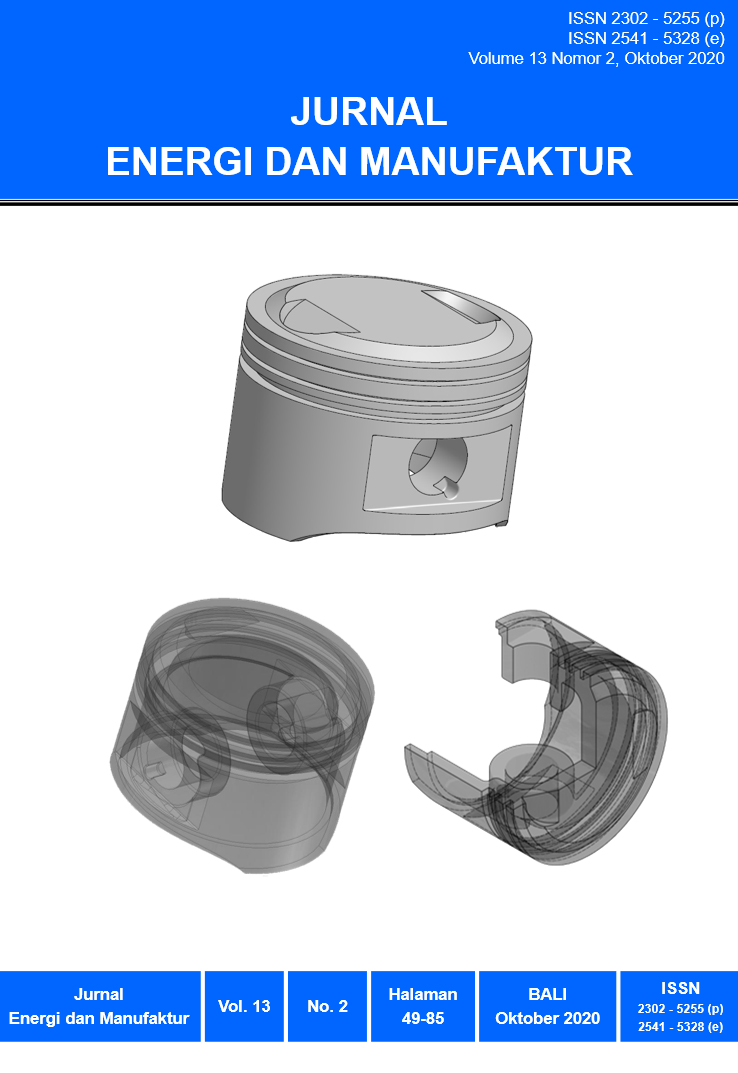Investigasi sifat mekanis sambungan Dissimilar Friction Stir welding (DFSW) Aluminium Alloys (AA5052 to AA6061)
Abstract
The joint for two different materials (AA5052 and AA6061) can be done by the Dissimilar Friction Stir Welding (DFSW) process. Therefore, this study was conducted to analyze the mechanical properties of dissimilar welding joints. In this study the DFSW process uses a tool with a shoulder Ø 17.8 mm and a cylindrical pin Ø 5 mm. FSW blocking is done on conventional milling machines with 1300 rpm, 1950 rpm and 2850 rpm tool rotation variations, while the welding speed variations are 43 mm / min, 130 mm / min and 240 mm / min. The results of mechanical properties testing showed the highest hardness value obtained was 55.3 HBN at 1300 rpm with 240 mm / min feeding, the highest tensile strength occurred for 1300 rpm and 240 mm / min feeding at 123.51 MPa. The fracture of the tensile test results generally occurs in the HAZ area and the AA5052 base metal Nugget. Investigation results show that the DFSW connection of aluminum alloy material AA 6061 and AA 5052 adapt is well connected, but in terms of general strength the tensile strength of the joint (HAZ and Nugget) is smaller than the tensile strength of the base metal. This DFSW connection adaptation is applied to connections that do not accept load or tensile strength due to the load received by the connection not to exceed the maximum tensile strength of base metal AA 5052
Downloads
References
[2] Biradar NS, Raman R 2012 Investigation of hot cracking behavior in transverse mechanically arc oscillated autogenous AA2014 T6 TIG welds Metall Mater Trans A Phys Metall Mater Sci. 43(9)3179–91
[3] Leon JS, Jayakumar V 2015 Investigation of Mechanical Properties of Aluminium 6061 Alloy Friction Stir Welding Int J Students’ Res Technol Manag. 2(4)140–4
[4] Howeyze M, Arabi H, Eivani AR, Jafarian HR 2018 Strengthening of AA5052 aluminum alloy by equal channel angular pressing followed by softening at room temperature Mater Sci Eng A. 720160–8
[5] Malopheyev S, Vysotskiy I, Kulitskiy V, Mironov S, Kaibyshev R 2016 Optimization of processing-microstructure-properties relationship in friction-stir welded 6061-T6 aluminum alloy Mater Sci Eng A. 662136–43
[6] Nandan R, DebRoy T, Bhadeshia HKDH 2008 Recent advances in friction-stir welding - Process, weldment structure and properties Prog Mater Sci. 53(6)980–1023
[7] Hasan MM, Ishak M, Rejab MRM 2018 Effect of pin tool flute radius on the material flow and tensile properties of dissimilar friction stir welded aluminum alloys Int J Adv Manuf Technol. 98(9–12)2747–58
[8] Nur R, Sultan AZ, Suyuti MA 2017 Mechanical properties on friction stir welding of aluminum alloy 5052 ARPN J Eng Appl Sci.
[9] Mishra RS, Ma ZY 2005 Friction stir welding and processing Mater Sci Eng R Reports. 50(1–2)1–78
[10] Iswar M, Suyuti MA, Nur R 2019 Optimizing the machining conditions on friction stir welding of aluminum alloy through design experiments InAIP Conference Proceedings.
[11] Balamurugan S, Subbaiah K 2019 Tool Pin Profile Studies on Friction Stir Welded Joints of AA5052-H32 and AA6061-T6 Aluminum Alloys InAdvances in Manufacturing Processes. Springer; p. 663–70

This work is licensed under a Creative Commons Attribution-NonCommercial-ShareAlike 4.0 International License.









